Today we meet for the last time on this coffee trip. We are going to visit Cooagronevada1 (a neologism made up of Cooperativa (cooperative) agrocultura (agriculture) and Sierra Nevada (region near Santa Marta)). In 2007, 21 families of coffee farmers joined together to form this cooperative.

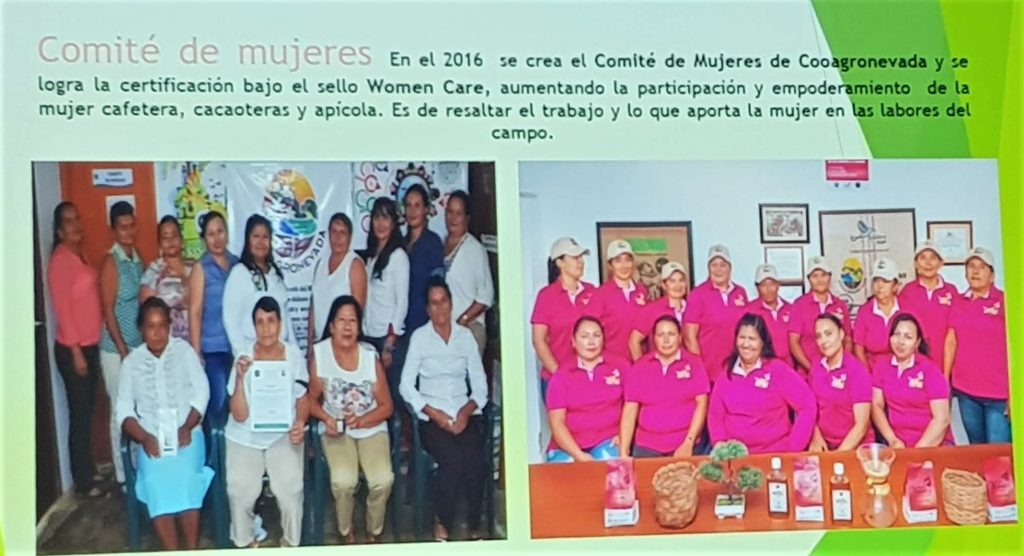
Today (2020) there are over 70 families involved and there is a special women’s committee with 26 members. This committee is working on equal rights for women in coffee farming families. As a result, the cooperative is now certified not only for fair trade and organic farming, but also “Women Care Certified®” (WCC).
The WCC seal was introduced by Alianza de Mujeres de Café de Costa Rica (AMCCR) (roughly: Alliance of Women in the Coffee Trade in Costa Rica) in 2015. It aims to draw attention to the special situation of women and promote opportunities and equality.Only farm families where the farm belongs to a woman can participate. Whether she is single or married does not matter.
Our guide today, Sandra Palacios tells us that a full 14 containers of Cooagronevada coffee received the Womens Coffee Seal in 2019.
The scientist Xiomy, who is also our tour guide, tells us a bit more about the background and the importance of such efforts for more equality. Here in northeastern Colombia, women today have somewhat more rights than perhaps elsewhere in the country. Surprisingly, this is due to the sad fact that paramilitaries were very active in this region.
During the peace process a particularly large number of grants were awarded here. These grants were intended to enable former combatants to earn an honest income by growing coffee. Don Omar, who we visited at the beginning of our trip, also told us about this.2
This history of promoting women may have made it particularly easy for Cooagronevada to find families where the farm belongs to a woman, and thus to qualify for the WCC seal.
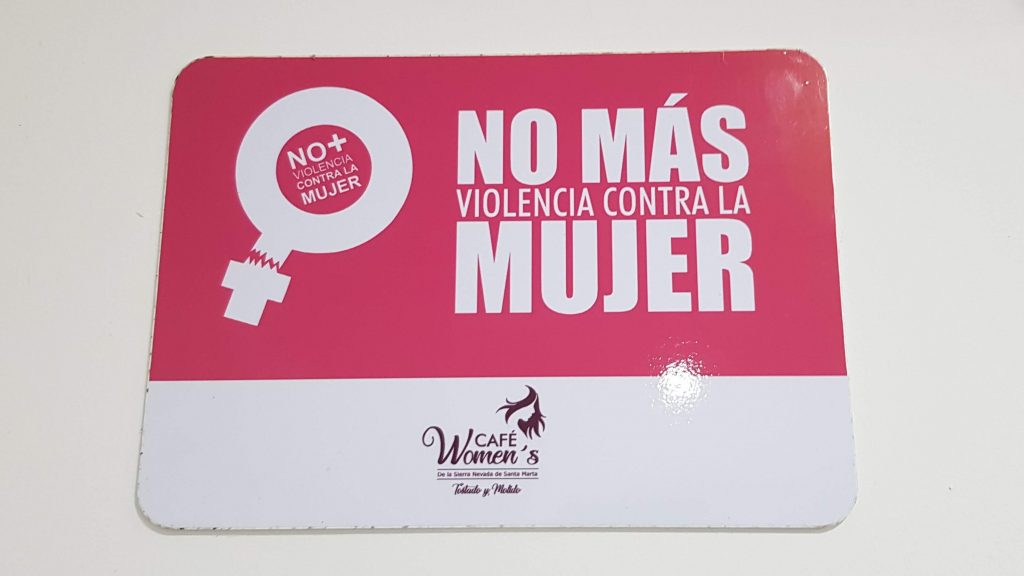

The cooperative also received support from elsewhere: students from the University of Bogotá developed a logo and special packaging for the women’s coffee. The project even donated the first 10,000 packages so that the cooperative could put the design to use immediately.
This way it’s easier to market and sell under its own brand. This means that the women can no longer just grow the coffee, but also roast, package and sell it directly themselves.
The big advantage: more steps of the value chain remain in the country of production and thus a larger share of the profits (see also interview with Natalie Weiß – click here).
In order to have other sources of income, the cooperative also runs its own café where they serve coffee specialties. We don’t have time to visit the Café Donama3 this time – but I am enthusiastic about the idea and firmly plan to visit it on my next trip to Santa Marta.
As with “Arte y Pasion” in Bogotá , this project achieves several important goals at once. On the one hand, the increase in profits already mentioned. Secondly, it changes the role of the coffee farmers by increasing their skills. And thirdly, it promotes the domestic consumption of good coffee.
This is also a concern of many players in the Colombian coffee market: to inspire their own countrymen to enjoy better coffee quality. Currently, as in most coffee-producing countries, a simple, cheap coffee is drunk by the locals. In Colombia, it is called “Sello Rojo” (red seal). This is a cheap ground coffee that is sold on supermarket shelves and contains mainly the less valuable beans that are not suitable for export.
A young and ambitious generation of cafeteros and cafeteras wants to change this state of the art: with barista courses in Bogotá, with participation in cupping championships, but also with cafés in smaller towns like Santa Marta.
And of course, with the training of people who can better evaluate the quality of the coffee themselves. Currently, they are still happy having “professionals” from Europe or the USA visiting – not only because of the hope for a long-term trade relationship with fair prices, but also to get feedback on their own product. How do the importers like the taste of the coffee? How many points on the SCA scale would it get? And related to that: how valuable is it? As well as an assessment of the expansion of the product range: which additional products could we export?
A broader product range leads to less dependence on the price of coffee, as it allows for further income, which minimizes the risk associated with dependence on just one product. Because in Colombia, too, people are feeling the effects of climate change: it is getting warmer. And thus more difficult to grow coffee. In the Sierra Nevada, many farmers have no choice but to grow coffee in the cooler zones further up the mountain.
To do so, they have to cut down forests; there is no other way to secure their livelihoods. So in order to become a little less dependent on coffee and have an alternative source of income, the women of Cooagronevada rely on other products such as honey and cocoa.
Cocoa has the great advantage for them that it requires a similar climate as coffee, but the trees are somewhat more robust against temperature changes. In addition, there is a large market – in Germany, for example, we consume 10 kg of chocolate per person every year! Unfortunately, most of it comes from non-sustainable cultivation and so far only 16% of the world’s cocoa comes from Central and South America. And so it is not yet entirely clear whether the cultivation of cocoa in Colombia is financially worthwhile in the long term. It is difficult with chocolate that is not fair trade: only about 7% of the cocoa price stays with the farmer, which is about 6 cents for a cheap bar (89 cents for 100 grams of milk chocolate)4.
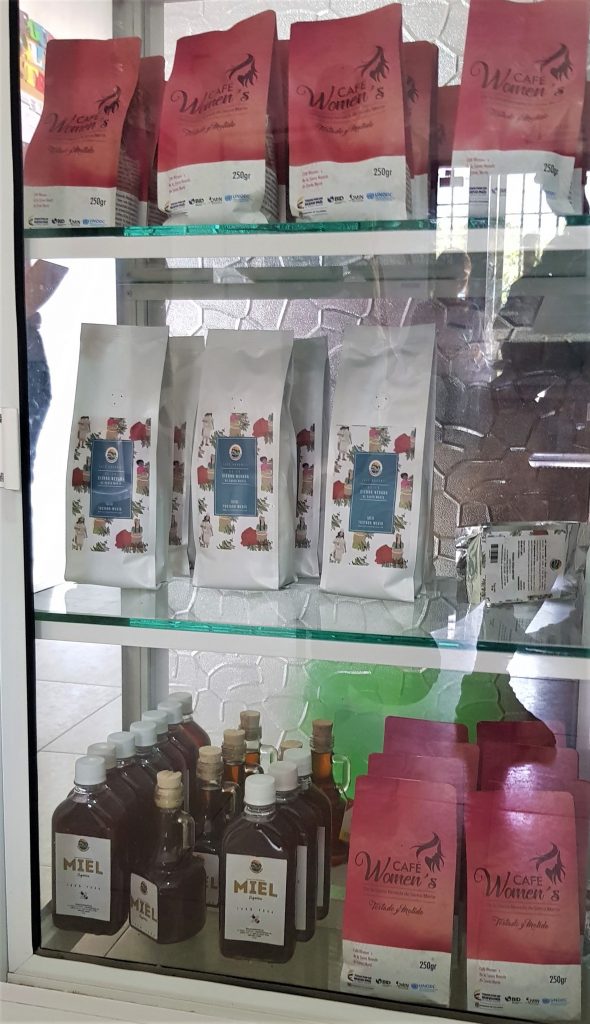
Another disadvantage is that cacao trees only blossom after 5-6 years and only produce their full yield after 12 years. In return, however, they then blossom and bear fruit all year round and can live for up to 100 years.
In addition, for cocoa, too, the market must first be analyzed, customers found for the products, trade relationships established and the wishes of the end customers also taken into account.
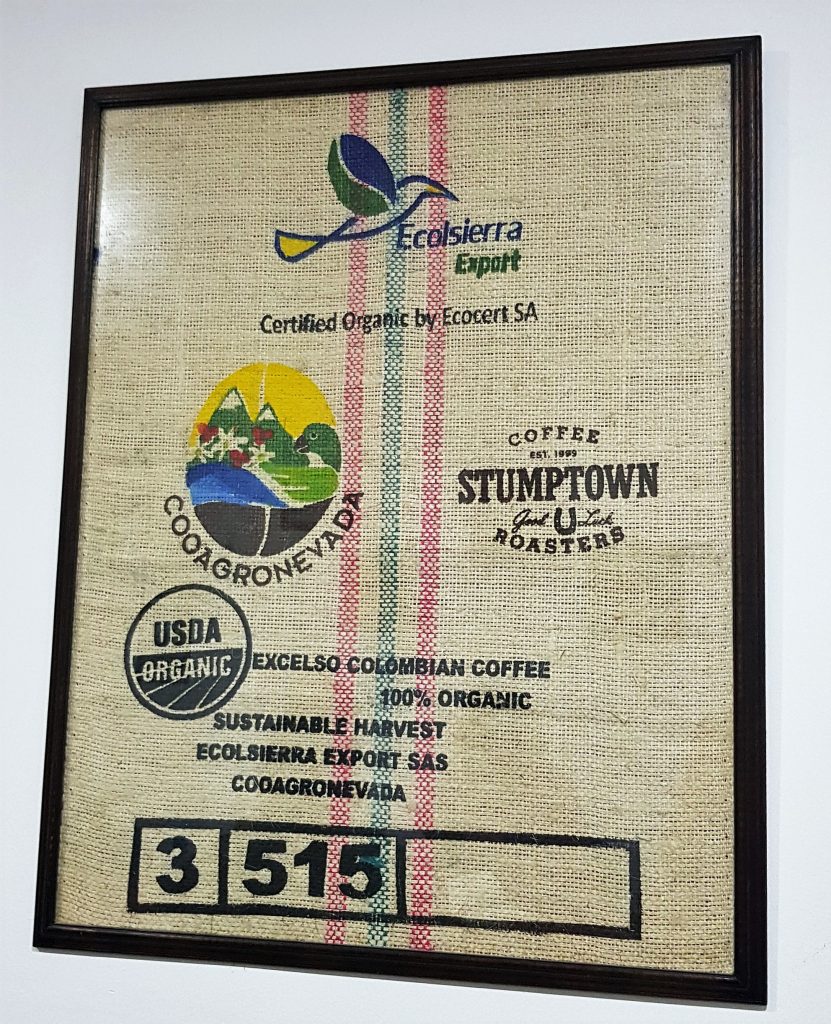
In coffee exports, on the other hand, Cooagronevada is now well established, even as a producer of specialty coffee.
Sandra tells us about two customers who only buy coffee with at least 84 SCA points5.
By no means can all female comrades deliver this quality; only some of them reach 85 points. And what happens then?
If a coffee scores only 83 points, it is blended with coffee that scores 85 points to obtain, on average, the score desired by the customer.
The price that the comrades receive from the cooperative is made up of the basic price, plus surcharges for organic cultivation and also for better quality.6
From Sandra I would like to know: Wouldn’t a direct trade of only their coffee be more lucrative for the women with the higher quality? Because the interest in Microlot coffee increases, as already described in other articles of this journey. However, the blending means that the coffee can no longer be sold as varietal/microlot.
But Sandra’s answer is a firm no. She generally doesn’t think much of the idea of individual comrades selling their coffee on their own. This would undermine the idea of solidarity within the cooperative. And so Cooagronevada sells blends exclusively. This way, they may not achieve the absolute top prices that third wave coffees (single lot, mircolot) achieve, but they ensure long-term solidarity among the growers.7
If you grow a good variety as a cooperative and have a good year, it might be very lucrative to sell the coffee directly this year and not as part of the cooperative blend. But next year, the weather situation may be different and you may not achieve the same quality. It’s these individual risks that the cooperative aims to reduce.
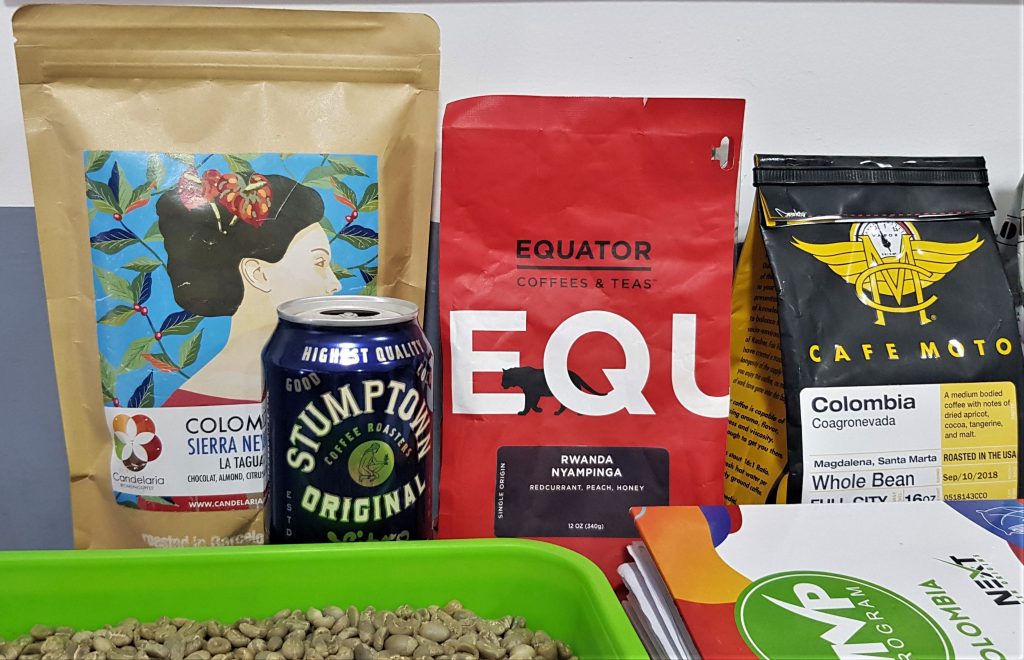

After all the information, we finally get to cupping, the coffee taste testing. We taste that people here have thought about the quality of their coffee. Cooagronevada also refines their coffee with processes like honey8.
So they have improved the flavor profile of their coffee and made it more interesting.
For many coffee drinkers, however, taste is not the only factor. More and more the question is: where does the coffee come from, who grew it? How are these people doing?
As with all the cooperatives and coffee farmers we have visited on this trip, I again meet dedicated people, both men and women, who are eager to grow good coffee and sell it for a price they can live well on.
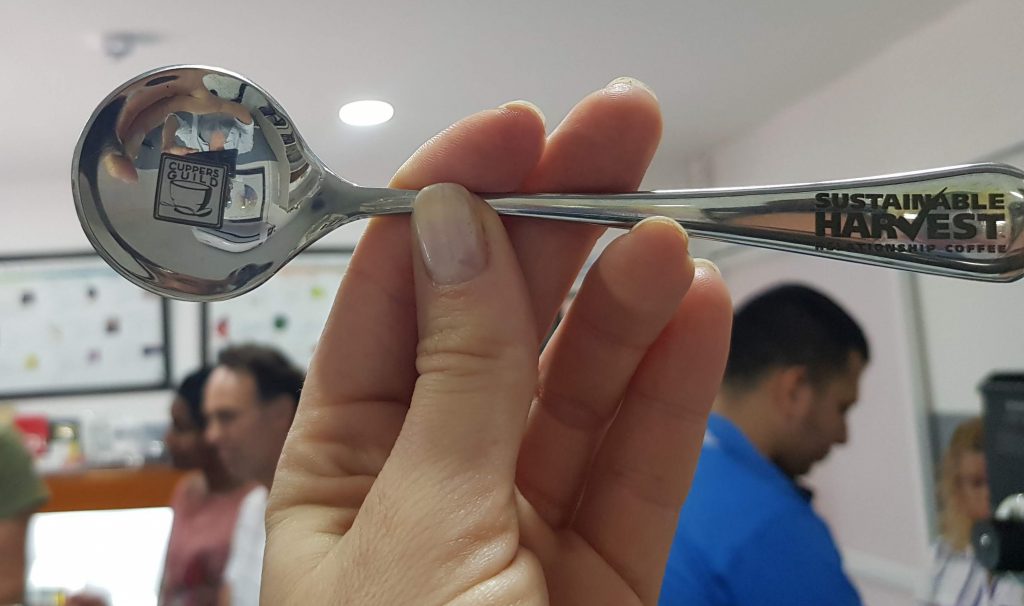
That should be the goal of all of us!
Because isn’t it crazy that many people are willing to pay almost 6 € at the US coffee chain Starbucks for a “Venti Pumpkin Spice Latte Decaf Soymilk” (the most popular drink in autumn, which has claimed to have something to do with pumpkin and coffee, but which in principle only consists of fat and sugar 9) but balk at the same price for a 250g packet of coffee (which would easily be enough to make 15 Spicy Lattes at home10)?
Ich denke: Wir müssen dahin kommen, dass der Konsum von fair gehandeltem Kaffee und generell der Kauf von fair gehandelten Produkten zum Standard wird!
I think: We have to get to the point where the consumption of fair trade coffee and generally the purchase of fair trade products becomes the standard!
And so, as I write this article, I sit in faraway Germany drinking a cup of Rebeldia from the Café Libertad collective11.
By the time the coffee has made it into my cup, it has traveled a long way. A picker, probably from another part of the country and sleeping for weeks in a multi-bed camp, has picked the ripe coffee cherries on a steep slope under a blistering sun or in the pouring rain. He carried them to the scales and got at least the minimum wage for them. Or maybe it was the coffee farmer who picked the coffee herself. The coffee was washed, hulled, dried. Packed into bags. Carried on the back of a mule from the slopes of the Sierra Nevada to the village crossing the bridge built by the cooperative. There weighed, inspected, purchased and stored by the cooperative. From there brought by pickup truck even further down to the central warehouse of the cooperative. Here perhaps again after-dried: Thus again out of the bags, in the sun spread, again in back into the bags packed. Stacked up into a veritable maze in the warehouse. Brought from the temporary storage to the main storage in Santa Marta, sorted, packed into bags again. Finally carried on trucks to the port of Santa Marta – fortunately the sea is close here.12
On a ship, the coffee crossed the ocean for several weeks before it arrived in Hamburg. In the Hanseatic city, it was stored at the Café Libertad collective. Checked again. Transported to the roaster. Roasted and packed. Back again. And finally sent to me by post. Madness I think. I sit back and enjoy the coffee all the more!
1 https://cafecooagronevada.com/ , https://cafecooagronevada.com/who-we-are/?lang=en
2 He felt it was unfair that former guerrilla fighters received start-up aid in coffee cultivation, while he received no support because he had already been a coffee farmer before.
4 https://www.bmz.de/de/zentrales_downloadarchiv/gruene_woche_2018/Faktenblatt-Kakao_IGW.PDF, checked 26.11.2020.
5 SCA is the Specialty Coffee Association. A “normal” coffee is always below 80 points, from 80+ the specialty coffee begins. From 80-84.99 points the coffee is considered very good, from 85-89.99 points excellent and from 90-100 points outstanding. Not even 1% of the coffee harvested worldwide receives this top rating. Cf. https://www.coffeecircle.com/de/b/specialty-coffee-definition, accessed 12/1/2020.
6 Most comrades grow coffee with a quality of 82 to 83 points.
7 If you wanted to grade the quality of coffee, the bottom grade is simply a blend of beans bought together from around the world. Thrown together to suit our Jakobs coffee taste. We have been drinking this coffee in Germany for years as well. We find it in many packages from Tchibo, Melitta but also the supermarkets’ own brands. At the next stage of the coffee evolution, the realization that coffee from different regions tastes different slowly took hold. Coffees were (and still are) marketed that come only from certain countries. At the next stage, the whole thing becomes even more small-scale – it’s all about specific regions, analogous to wine. The final way to specify more regionally now is to limit it to a single hillside – a microlot. Quasi a coffee from Sandra’s south slope
8 Honey processing means that when the coffee bean is washed, the thin mucous membrane is not completely removed. This naturally contains sugar. During drying, this sweetness remains in the coffee.
9 https://www.stern.de/genuss/pumpkin-spice-latte-starbucks-ungesund-7125534.html, accessed 11/24/2020
10 If we assume that there is a double espresso in such a drink, which is usually prepared with 17 g of coffee powder (see, for example, https://kaffeemacher.ch/espresso-zubereiten/, accessed 11/26/2020)
11 You can order the coffee here: https://www.cafe-libertad.de/rebeldia (this is NOT an affliate link, so I do NOT get any money if you click on this link)
12 If the coffee was not grown inland, like Don Omar’s coffee – then of course there is a longer way to the sea.




